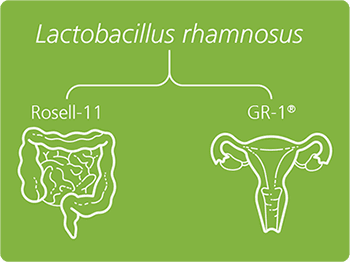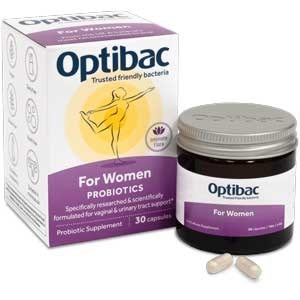The Cure-All Myth
The Myth:
"All probiotics do the same thing."
Research says:
Different probiotics have different benefits. For example, clinical trials show L. rhamnosus Rosell-11 supports gut health, yet research shows L. rhamnosus GR-1® supports vaginal health.
In a healthy state there is a huge diversity of microorganisms in our body. There are similarities between some microorganisms but they have subtle, and often significant, differences in how they help with various aspects of our health. As a general rule of thumb, Lactobacilli tend to live in the small intestine and their properties include the secretion of digestive enzymes to help break down food, whereas Bifidobacteria tend to live in the large intestine and amongst other benefits, are important to ensure we have regular bowel movements. However, within each of these genus of bacteria there are many species, and within each species there are many strains; these strains have been shown to have different effects on the body.

For example, in comparing the properties of two different strains from the same species: L. rhamnosus, it soon becomes apparent that they have totally different attributes. L. rhamnosus Rosell-11 has been shown in numerous clinical trials to stabilise gut health when taking antibiotics, and to reduce the risk of associated digestive symptoms1. L.rhamnosus GR-1® on the other hand has not been shown to directly aid digestive health; instead it has been shown to colonise in the vaginal tract2 and to help maintain balance in the microflora of the intimate area, especially in common intimate health conditions3, 4 ,5.
Lactobacillus rhamnosus GR-1® is one of the strains in Optibac Probiotics For Women.
Health professionals can view both strains of L.rhamnosus on the Probiotics Database: L. rhamnosus Rosell-11 L. rhamnosus GR-1®
When it comes to probiotics, research shows us time and time again, that it is certainly not a case of ‘one-size-fits-all’.
Look out for:
Specific probiotic formulas with specific strains – for the most benefit for each individual.
Further Reading
Probiotics for UTI - a look at the research.
Are all types (strains) of friendly bacteria the same?
This myth has been busted by Megan Crowch, BSc (Hons) Physiology, Herbal Medicine Diploma (IRH practicing member).
References
- Foster et al. (2011) A comprehensive post-market review of studies on a probiotic product containing Lactobacillus helveticus R0052 and Lactobacillus rhamnosus R0011. Benef Microbes; 2, 4: 319-34.
- Reid et al. (2001) Oral probiotics can resolve urogenital infections. FEMS Immunol Med Microbiol; 30, 1: 49-52.
- Martinez et al. (2009) Improved treatment of vulvovaginal candidiasis with fluconazole plus probiotic Lactobacillus rhamnosus GR-1 and Lactobacillus reuteri RC-14. Lett Appl Microbiol; 48, 3: 269-74.
- Beerepoot et al. (2012) Lactobacilli vs antibiotics to prevent urinary tract infections: a randomized, double-blind, noninferiority trial in postmenopausal women. Arch Intern Med; 172, 9: 704-12.
- Anukam et al. (2006) Augmentation of antimicrobial metronidazole therapy of bacterial vaginosis with oral probiotic Lactobacillus rhamnosus GR-1 and Lactobacillus reuteri RC-14: randomized, double-blind, placebo controlled trial. Microbes Infect; 8, 6: 1450-4.
You might also be interested in:
The Research Myth
The Antibiotic Myth
The Strain Myth
The Survival Myth
The Numbers Myth
The Foodl Myth
The Billions Myth
The Fridge Myth

